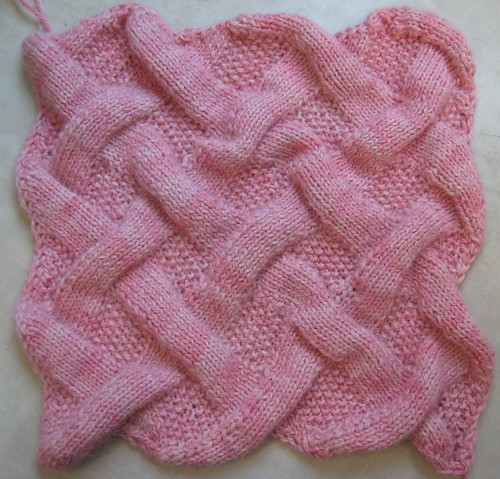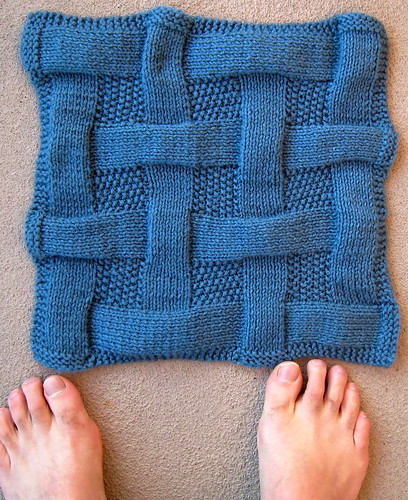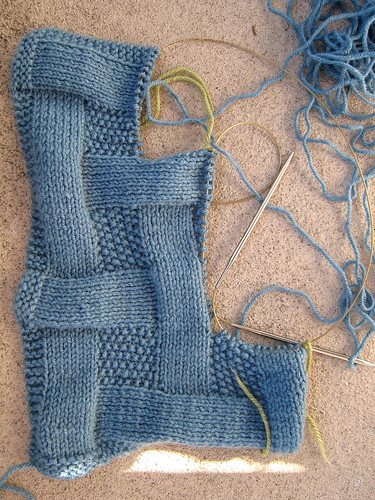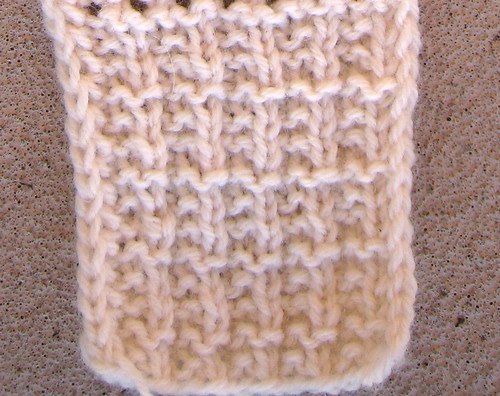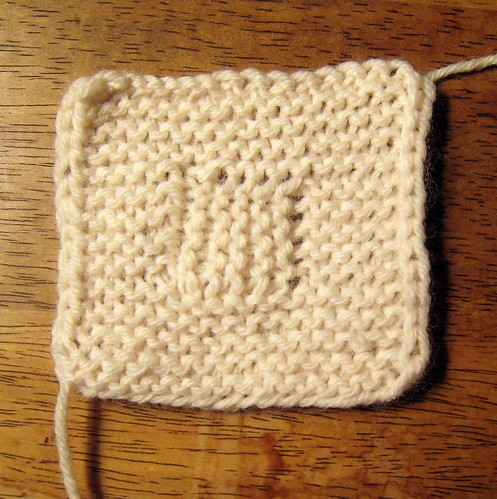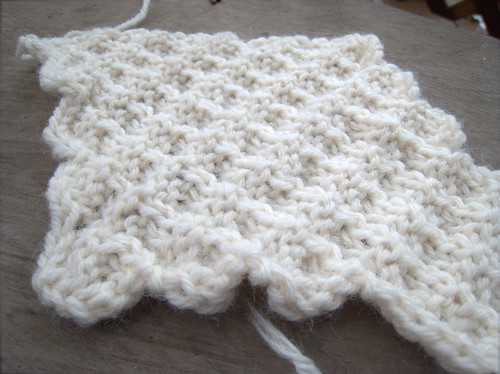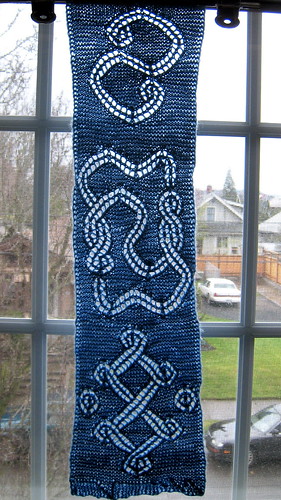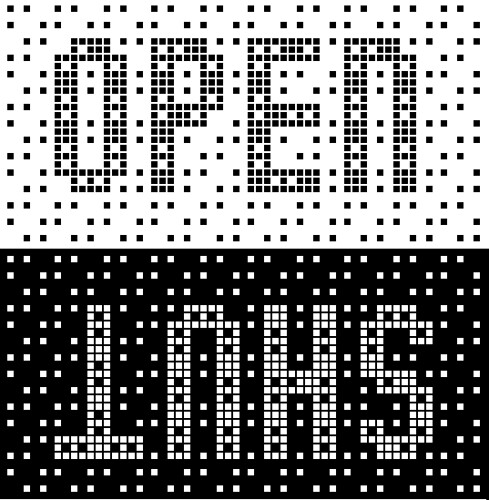This is an earlier version of the zig-zag entrelac, before I used the sliding-loop technique to join the units. It's not as neat if you look closely, and the back-side is not as perfect.
Sunday, January 25, 2009
Tuesday, January 20, 2009
Zig-zag entrelac complete
This is created by stair-step or zig-zag entrelac units. It's a very neat construction, as you can see from the reverse. My own design
Saturday, January 17, 2009
visualize whirled peas
An example of a motto written in the Fontstruct mosaic knitting font I created called Mosaic4way. It shows the miserable letterspacing ("rl" is pretty bad) inherent to the mosaic technique, or at least to this type, where my goal was to create letters that can be knitted from any of four directions.
Friday, January 16, 2009
3-row reversible knit-purl III
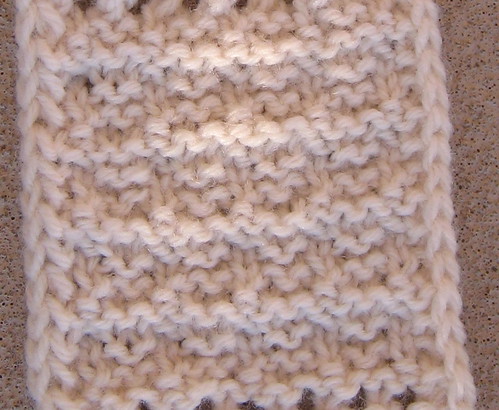 3-row reversible knit-purl III, originally uploaded by fuzzyjay.
3-row reversible knit-purl III, originally uploaded by fuzzyjay.Multiple of 3. Row 1 and 2: *Knit 1, purl 1, knit 1, repeat from *. Row 3: Knit.
This one is either subtle or just chaotic... there's a slight emphasis to the purl ridges, but otherwise it just looks tweedy.
3-row reversible knit-purl IV
Multiple of 3.
Rows 1 and 2: *Knit 2, purl 1, repeat from *.
Row 3: Knit.
This is my favorite so far. It looks a little like purl ridges overlaid onto knitted ribs overlaid on garter stitch. On both sides, for very little effort.
Monday, January 12, 2009
Knitted inset (garter stitch)
I think this technique works better in stockinette stitch now that I've seen what it looks like in garter stitch. I may have to change the inset to "reverse" garter stitch (purl every row) so that it will sit better in the frame of garter stitch.
Sideways inset
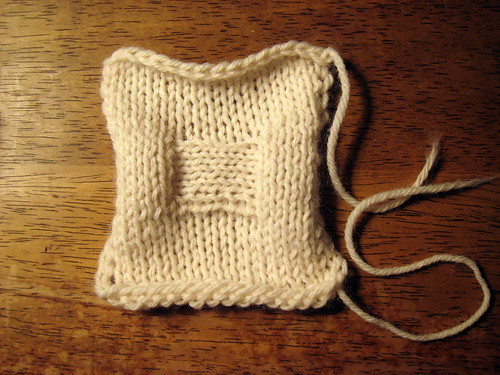 Sideways inset, originally uploaded by fuzzyjay.
Sideways inset, originally uploaded by fuzzyjay.Not pretty, perhaps, but interesting. This inset is knit using the sliding-loop technique invented by Rick Mondragon. He applied it to intarsia color knitting, but it also lends itself to knitting at 90 degree angles. Take a stitch that's being held on the needle and pull a loop through it. This loop becomes the yarn that is used for two rows of knitting. I'll have to come up with a better way of explaining this.
To view the reverse side of this swatch go to the flickr page for the photo: http://flickr.com/photos/fuzzyjay/3191099608/
Sunday, January 11, 2009
reversible knitting swatch
Here is the promised picture of the 3-stitch-3-row-repeat knitting pattern described in an earlier post.
Saturday, January 10, 2009
Cleansing the palate
I just knit a swatch of a 3-row, 3-stitch-repeat pattern that I like.
Cast on a multiple of 3 stitches.
Row 1: *Knit 1, purl 2, repeat from * to end.
Row 2: same as row 1
Row 3: Knit.
It has (barely) mostly knit stitches (5:4 knit:purl). It has a very intriguing texture, almost like a waffle weave. And, of course, since it’s 3 rows, it’s a reversible fabric.
Here’s the chart:
I’ll post a picture soon.
Friday, January 09, 2009
Some one-row patterns
1x1 Ribbing and Seed stitch
Ribbing
Ribbing can be written as one-row or two-row, depending on the number of stitches per row, even or odd. For simplicity I’ll start all the instructions with a knit stitch.
Even number of stitches
Simplest example: one-and-one ribbing is easy with an even number of stitches:
Cast on an even number of stitches.
Row 1: *Knit 1, purl 1, repeat from * to end of row.
Repeat Row 1.
As opposed to garter stitch (see previous entry) I don’t need two rows to diagram it:
Odd number of stitches
But to knit one-and-one ribbing on an odd number of stitches the written instructions are not quite as simple…
Cast on an odd number of stitches.
Row 1: *Knit 1, purl 1, repeat from *, end knit 1.
Row 2: *Purl 1, knit 1, repeat from *, end purl 1.
Repeat rows 1-2.
And the chart needs to be a little more complicated (heavy lines represent stitch repeats):
In general, to knit flat ribbing so that it is symmetrical (the left half mirrors the right half of the fabric) requires two rows of instructions.
Seed Stitch
Odd number of stitches per row
If I were to repeat only row 1 (or row 2) of the directions for 1x1 ribbing on an odd number of stitches, I would get Seed Stitch. Using row 1:
Cast on an odd number of stitches.
Row 1: *Knit 1, purl 1, repeat from *, end knit 1.
Repeat Row 1.
Even number of stitches per row
What about Seed Stitch on an even number of stitches? I need two rows for the instructions:
Cast on an even number of stitches.
Row 1: *Knit 1, purl 1, repeat from * to end of row.
Row 2: *Purl 1, knit 1, repeat from * to end of row.
Repeat rows 1-2.
And I need two rows for the chart:
Summary
1x1 ribbing
| Stitches per row | Number of rows in instructions | Number of rows in graph |
| Even | 1 | 1 |
| Odd | 2 | 2 |
Seed stitch
| Stitches per row | Number of rows in instructions | Number of rows in graph |
| Even | 2 | 2 |
| Odd | 1 | 2 |
Knitting patterns with an odd number of rows
Knitting patterns that have an odd number of rows are reversible when knitted flat. They are not well and truly reversible, since they will shift vertically the height of a row repeat. For many applications, though, they are practically reversible.
The simplest one: garter stitch.
Row 1: Knit. Repeat Row 1.
Or:
Row 1: Purl. Repeat Row 1.
Every odd-row pattern can be worked in two ways (this is true of any knitting pattern I can think of at the moment). As a matter of fact, to produce the same fabric with circular knitting, you must work them one way, then the other. The only way to detect which way a fabric has been knitted it to check the selvedges. Even then, you have no way of knowing whether the knitter knit it forwards (from left to right needle) or backwards (from right to left needle).
When graphing odd-row patterns I’m tempted to graph only one row repeat, but to be fair to circular knitters and to better represent the way the fabric looks, I think it’s better to graph two row repeats, but label the rows with the row numbers twice.
For the simplest example, to diagram garter stitch, I’m tempted to do this:
But I really should do this:
…which would still be read as knit every row when working flat, but is more faithful to the appearance of garter stitch. Also, the diagram tells me that I need to work every other row as purl when I knit circularly, since when I knit circular I read every chart row from the right.
The diagramming example is slightly ridiculous, since the graph doesn’t add much to the written directions. Diagrams are most useful to me when they condense long, elaborate directions into a clear graph of the knitting.
Next: what are some other 1-row patterns and how are they graphed?
Abandoned entrelac star
 Abandoned entrelac star, originally uploaded by fuzzyjay.
Abandoned entrelac star, originally uploaded by fuzzyjay.I discovered how to increase on the right edge of an entrelac square to create a parallelogram that leans to the right, without using yarnovers as in my first entrelac star.
I am trying to create a hat that has 6 stars in it, one on the crown and 5 surrounding the crown. The tips of the stars touch, and the spaces between are filled with seed stitch or some other background. This kind of star would be good for some other pattern, but for a hat I prefer the way the center swirls a bit with the other type of star.
It's never too precise
I am severely INTP.
- I == Happiest in my head. Strong need for solitude. (Introversion over Extroversion.)
- N == Love to discover patterns, structure, connections between ideas. (Intuition over Sensing.)
- T == Objectively, I can understand how subjectivity is needed. “F” is supposedly the INTP’s weak point, but I tested on the fence. I think I have been forced to develop the F function by my personal relationships. Not to mention I’m 50, and some theories have you starting to explore your shadow side in midlife. (Impersonal over personal.)
- P == Can you say “work in progress”? New ideas call to me seductively as I try to finish what I’m working on. (Leaving open over coming to a conclusion.)
The structure of the knitted fabric intrigues me. The representations, notations, charting, diagramming of knitting fascinates me. New ideas in knitting excite me (Norah Gaughan, Debbie New, Barbara Walker, Elizabeth Zimmerman).
My former partner was a weaver, and he is an ESTP. I remember reading somewhere that weavers are either pattern/structure or color/texture. He is the latter and I am the former. He is masterful with color. I am hopeless with it. I usually prefer to knit in one color of yarn and I am only now beginning to trust variegated yarn (I want a yarn that will show the structure of the knitting…) now that there are subtle versions of variegation.
Actually, I prefer charting a knitting pattern and letting other people perform the actual knitting. Most of my knitting is done to “flesh out” an idea and see if it actually knits up as I imagined it.
Most of my knitting is done with invisible needles and imaginary yarn.
Thursday, January 08, 2009
Wednesday, January 07, 2009
Friday, January 02, 2009
Knitting shop sign?
This is a pattern for mosaic knitting. It could be used as a sign for a knitting shop.
Mosaic4Way character set
 Mosaic4Way character set, originally uploaded by fuzzyjay.
Mosaic4Way character set, originally uploaded by fuzzyjay.This shows all the characters for my font Mosaic4way. I created the font with FontStruct and on that site you can download the font as a TrueType font suitable for both Mac and PC. Available at fontstruct.fontshop.com/fontstructions/show/122553 .
Confessional mode
The last few days I have felt profoundly uninspired. I have tons (or tonnes) of diagrams I could knit up, I have cast on and partially knit many of the ideas (all involving entrelac cubes that are made up of multi-square sections, and some involving stitch patterns other than stockinette) but none seemed worth continuing.
I know this mood is temporary, but I hate the wait for it to end.
How do you cope with these moods when you’re trying to serve your creations? I have heard of people that soldier on, just letting the fingers move when the brain is not engaged. I’m not one to do that.
